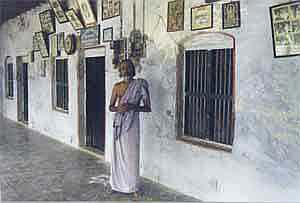
|
|||||||||||||||||
|
| |||||||||||||||||
Traditions of Tiruchendur
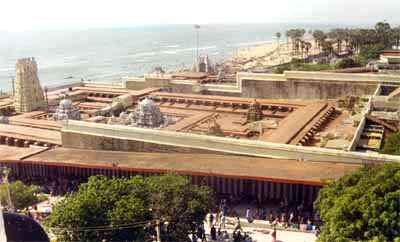
Tiruchendur in the far south of Tamil Nadu is renowned among Murugan devotees everywhere as one of the greatest of the Lord's Aru Padai Veedugal, literally 'Six Battle Camps'. Indeed, it is here that Murugan and his deva-sena or army of celestials confront and vanquish the titan Surapadma and his demonic horde. This momentous struggle is annually re-created at Tiruchendur on the sixth day of Skanda Sasti, the 'Six (days) of Skanda'. The Tiruchendur Devasthanam and sacred area date from hoary antiquity. Some stone columns and inscriptions date from a thousand years ago, though most of the present temple dates from later periods. Literary evidence, however, including notably the Tirumurukarrupadai, indicates that Tiruchendur has been regarded as exceptionally sacred at least since the early Christian era and probably far earlier. 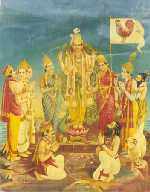
According to tradition, after the final battle on the beach at Tiruchendur, Lord Murugan felt remorse for His role in slaughtering Surapadma's demonic army. He therefore built a shrine nearby to His Father Lord Siva and worshipped Him there. Technically, therefore, the temple is dedicated to Lord Siva. Yet the mulasthanam deity is Lord Senthil Andavar Himself standing in a majestic and relaxed pose facing east towards the sea, alone and without His consorts Valli and Devasena.
Kanda Sashti vowsMurugan bhaktars traditionally regard Kanda Sashti as an opportunity to undertake such vows as:
Angapradakshina is a specialty at Tiruchendur. During Kanda Sashti one may see hundreds of men, women and children rolling the 400-500 meters around the shrine with heads towards the deity in the early morning hours. Fasting is also very common not only at Tiruchendur but among traditional Murugan devotees all over the world. These acts loosen one's attachment to the body and help to draw one's attention towards the ever-present absolute Reality that transcends life and death. Many also regard vows as small ways of obtaining the Lord's grace or repaying His generosity. Treat Tiruchendur Murugan with respect and affection, and He will return your affection many times over. Though full of might and danger for the heedless and proud of this world, towards His friends He is tender and supportive, if also inscrutable. What to see at Tiruchendur Kanda SashtiDuring Kanda Sashti, Tiruchendur throngs with tens of thousands of bhaktars from all over Tamil Nadu, especially from southern districts. Many are old hands who come year after year. Hence, Tiruchendur Kanda
Sashti is also an annual convention of sorts for the Lord's devotees. Unlike at many modern temples, there are no loudspeakers blaring film music. Yet during Kanda Sashti in recent years a closed-circuit television system allows devotees (hundreds of whom camp out inside the massive stone temple for six days or more) to view the rituals in the yaaga salai as well as cinema classics of Murugan devotion such as Kantan Karunai.
Outside the Devasthanam, especially in the outer praharam or circumambulatory corridor, parties of devotees may be seen singing bhajanai and performing kummi, dancing in group circles while clapping hands and singing. At the large open-air lecture hall nearby, hundreds enjoy the non-stop program of devotional talks by learned devotees. Of course, the seashore is very near and there are always hundreds there as well enjoying the most famous beach in Tamil Nadu. Just fifty meters from the beach is Naazhi Kinnaru, the miraculous freshwater spring which Lord Murugan is said to have created with His Vel to quench the thirst of his warriors after the great battle. For young and old alike, Tiruchendur Kanda Sashti is an unforgettable occasion. Festival climax: The Surasamharam BattleThe high point of Kanda Sashti, of course, is on the sixth day when the Surasamharam or 'Destruction of the Titan' takes place. At many Murugan temples this is ritually re-enacted, but nowhere is it re-enacted on such a scale as at Tiruchendur, where the actual battle is believed to have taken place in pre-history. On that day, half a million devotees descend upon Tiruchendur to witness the final shoot-out on the vast beachfront. Nowadays the event is also telecast on Indian radio and television for millions more to see.
Needless to say, it is a challenging task to come anywhere near the battle site. Specially-erected barriers and hundreds of special duty police are there to hold back the massive and exited crowd. But if you are adventurous and light-footed it is possible to enter into the midst of the action, taking care not to get trampled in the process. In brief, the Surasamharam goes like this. Around 3pm or so, a huge palanquin bearing the titan Gajamukha ('Elephant-faced') is carried by men of a local caste group down to the beach where he stands and dares Senthil Andavar to come out of His temple and fight. Some say that Gajamukha is "Surapadma's brother". But the most ancient Tamil traditions mention only the terrible and cruel Soor ('Terror' personified) who is described as a shape-shifter who can take any form and who cannot be killed. More recent traditions speak of Surapadma and his three 'brothers' who successively confront Murugan and are annihilated each in turn. Not one to turn away from a fight, Lord Murugan emerges from His Kanda Sashti Mandapam borne on a smaller palanquin by Brahmin men devotees. In the form of a modest-sized brass likeness of the Lord with His Vel or spear held aloft ready to hurl, He is garlanded with lemons, an essential ingredient of South Indian ritual magic. The Lord and His Vel gleam brightly in the afternoon sunlight with the Bay of Bengal as a stark backdrop. He appears relaxed but ready for single-handed battle.
The asura then runs around his divine Adversary borne by his loudly shouting troops, first clockwise, then counter-clockwise while Lord Senthil Andavar and His troops just remain at ease. Then the asura stands back and suddenly charges face-on but halts and draws back. He does this three times but the Lord is undisturbed. So the asura and his troops haul out and fire a missile (a real firecracker-sized rocket guided by a string between two poles held aloft). The missile heads straight towards the Lord, but something happens and the missile stops and turns back towards its senders, causing a roar of delight from the Lord's supporters. To film this properly, one has to get so close to the asura that sparks are flying at one's face and there is a real danger of getting trampled. The Lord and His troops then charge at the asura with lances drawn and with full battle cry. One young Iyer among them, who represents Lord Murugan, thrusts his spear at the asura and beheads it. The crowd instantly roars its approval. Then the asura army withdraws some fifty meters and regroups. A new head (of Simha-mukha, the 'Lion-faced' titan) is mounted on the asura's body and again the same things happen. Four times the procedure is repeated; the fourth time Surapadma himself (or his head rather) is represented by a live cock. When Surapadma is vanquished, symbolically he split by the Lord's Vel into the cock and the peacock, the Lord's banner-symbol and vehicle-totem respectively. On the following day (the seventh) there is the Tiru Kalyanam or marriage of Senthil Andavar to Lord Indra's daughter Devasena or Teyvanai Amman as She is best known -- the crowning acknowledgement of the Lord's triumph. This occurs at Tirupparankundram near Madurai but the same marriage is also celebrated in grand style at Tiruchendur.
Śrī Murugananda Sangeeta Tiruppukazh Sabha
As an ancient temple town, Tiruchendur is home to ancient traditions, of which Kanda Sashti festival is the most famous. Like any ancient pilgrimage center, however, Tiruchendur has witnessed slow but steady change over the centuries. Over the centuries, for instance, there have been times when local kings felt that more Brahmin priests were required to conduct the elaborate services for Lord Senthil Andavar. Today, however, there are so many Iyer families in Tiruchendur that most can scarcely make a decent livelihood by continuing their ancestral calling. One of Tiruchendur's fading traditions is its Śrī Murugananda Sangeeta Tiruppukazh Sabha, the 'Assembly for Music of Divine Praise of Murugan'. The Sabha has maintained its own spacious Tiruppukazh Manimantiram hall since its founding over sixty years ago. Even today a resident brahmachari maintains the hall and conducts daily services at its shrine room. But the aging and dwindling population of Tiruppukazh devotees in Tiruchendur finds it difficult to maintain its center there and has appealed to Murugan Bhakti to save it from eventual collapse. The entire center has been offered to Murugan Bhakti enthusiasts to develop into a residential ashram. For details about Tiruchendur and the Tiruchendur Tiruppukazh Manimantiramproject, write to the Murugan.org editor: kataragama@gmail.com. Tiruchendur.org official website of Śrī Subrahmanya Swami Devasthanam, Tiruchendur
|
![[Senthil Andavar murthy (16 kb)]](../pix/senthilandavar_mula.jpg)
![Mudikaani -- offering one's hair to Senthil Andavar [13k]](../pix/mudikani.jpg)
![Angapradakshina at Tiruchendur [19k]](../pix/angapradakshina.jpg)
![Nazhi Kinnaru [15k]](../pix/nazhi_kinaru.jpg)
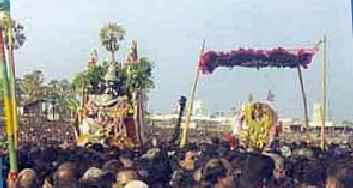
![Lord Senthil Andavar vanquishes Cur [15k]](../pix/surasamharan_stucco_1.jpg)
![Cur's forces fire live rockets at Senthil Andavar [7k]](../pix/rocket.jpg)
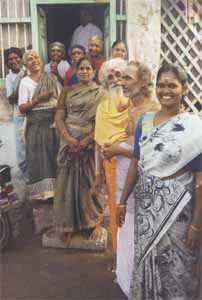
![Teyvanai-Senthil Andavar Tirukalyanam [9k]](../pix/tchen_wedding.jpg)
